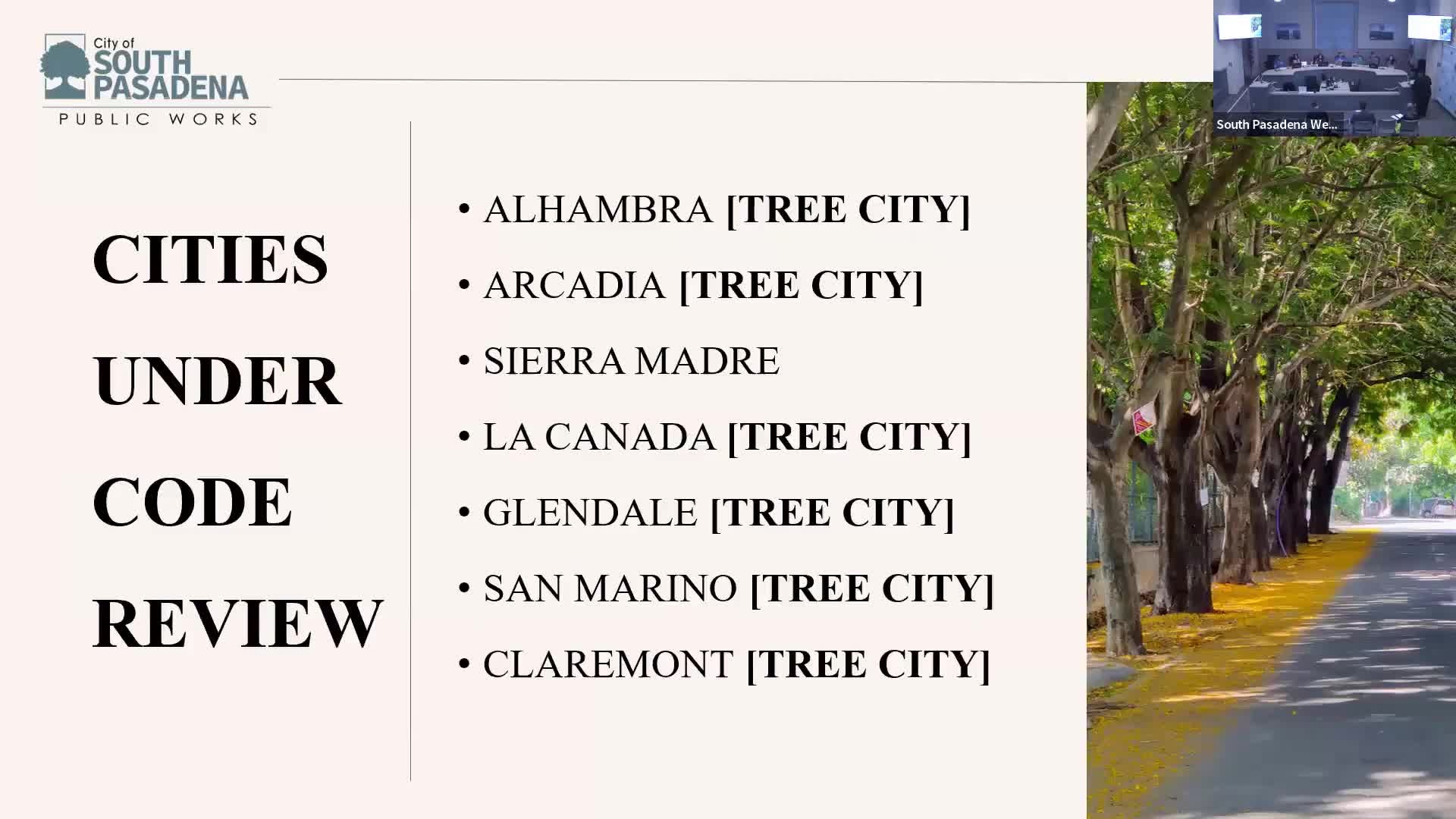Urban Forestry Review Reveals Key Tree Ordinance Insights from Various California Cities
May 28, 2025 | South Pasadena City, Los Angeles County, California
This article was created by AI summarizing key points discussed. AI makes mistakes, so for full details and context, please refer to the video of the full meeting. Please report any errors so we can fix them. Report an error »

On May 27, 2025, the Natural Resources & Environmental Commission of South Pasadena convened to discuss the city’s tree ordinance, focusing on its alignment with neighboring cities and the implications for urban forestry management. The meeting highlighted the importance of maintaining South Pasadena's status as a "Tree City," a designation that recognizes communities committed to tree planting and management.
The commission reviewed tree ordinances from nearby cities such as Alhambra, Arcadia, and Sierra Madre, noting that most are certified as Tree Cities. To maintain this designation, cities must enforce a community ordinance, celebrate Arbor Day, and allocate at least $22 per capita for urban forestry. The commission emphasized that their analysis was based on written policies rather than actual practices, indicating a need for improvement in enforcement and public understanding.
Key discussions centered on six focus areas: maintenance responsibilities, development and land use, trimming and pruning criteria, tree removal criteria, permitting processes, and enforcement compliance. The commission identified that while many cities have established advisory bodies to guide urban forestry issues, South Pasadena's current code serves more as guidance than a requirement, leading to confusion among residents regarding tree maintenance.
In terms of development and land use, the commission noted that various cities implement tree protection zones to safeguard trees during construction. These measures often include restrictions on heavy equipment and require detailed tree surveys conducted by certified arborists. The commission pointed out that when tree removal is necessary, cities typically mandate replacement plans to ensure the sustainability of urban forests.
The meeting also addressed challenges within South Pasadena's current ordinance, particularly regarding enforcement and the lack of a long-term urban forest strategy. Staff members are exploring ways to align the city’s code with current best practices and establish measurable benchmarks for urban forest management. This includes addressing tree planting, removal of hazardous trees, and developing guidelines for tree species suitable for different city corridors.
The commission discussed trimming and pruning criteria, noting significant variations among cities regarding permit requirements for tree maintenance. South Pasadena aims to clarify these guidelines to ensure compliance with industry best practices and improve public understanding of tree care.
As the meeting concluded, the commission underscored the need for a comprehensive management plan to enhance the city’s urban forest. This plan would address the planting of new trees, the removal of dead or hazardous trees, and the establishment of clear guidelines for tree maintenance. The discussions set the stage for future actions aimed at preserving South Pasadena's urban canopy and ensuring the community's commitment to sustainable forestry practices.
The commission reviewed tree ordinances from nearby cities such as Alhambra, Arcadia, and Sierra Madre, noting that most are certified as Tree Cities. To maintain this designation, cities must enforce a community ordinance, celebrate Arbor Day, and allocate at least $22 per capita for urban forestry. The commission emphasized that their analysis was based on written policies rather than actual practices, indicating a need for improvement in enforcement and public understanding.
Key discussions centered on six focus areas: maintenance responsibilities, development and land use, trimming and pruning criteria, tree removal criteria, permitting processes, and enforcement compliance. The commission identified that while many cities have established advisory bodies to guide urban forestry issues, South Pasadena's current code serves more as guidance than a requirement, leading to confusion among residents regarding tree maintenance.
In terms of development and land use, the commission noted that various cities implement tree protection zones to safeguard trees during construction. These measures often include restrictions on heavy equipment and require detailed tree surveys conducted by certified arborists. The commission pointed out that when tree removal is necessary, cities typically mandate replacement plans to ensure the sustainability of urban forests.
The meeting also addressed challenges within South Pasadena's current ordinance, particularly regarding enforcement and the lack of a long-term urban forest strategy. Staff members are exploring ways to align the city’s code with current best practices and establish measurable benchmarks for urban forest management. This includes addressing tree planting, removal of hazardous trees, and developing guidelines for tree species suitable for different city corridors.
The commission discussed trimming and pruning criteria, noting significant variations among cities regarding permit requirements for tree maintenance. South Pasadena aims to clarify these guidelines to ensure compliance with industry best practices and improve public understanding of tree care.
As the meeting concluded, the commission underscored the need for a comprehensive management plan to enhance the city’s urban forest. This plan would address the planting of new trees, the removal of dead or hazardous trees, and the establishment of clear guidelines for tree maintenance. The discussions set the stage for future actions aimed at preserving South Pasadena's urban canopy and ensuring the community's commitment to sustainable forestry practices.
View full meeting
This article is based on a recent meeting—watch the full video and explore the complete transcript for deeper insights into the discussion.
View full meeting
